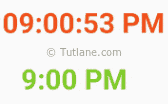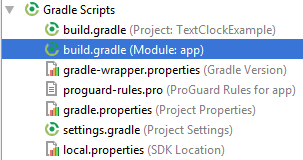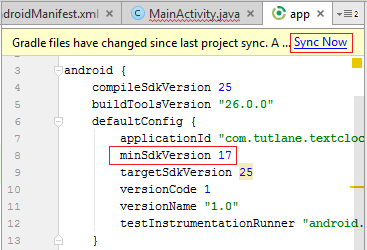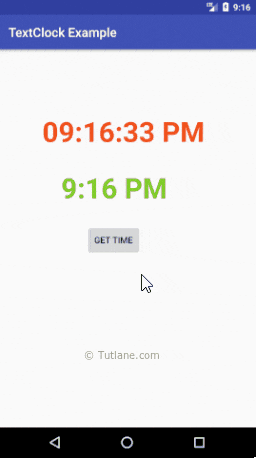In android, TextClock is a UI control which is used to show the current date or time as a formatted string.
The TextClock provides a date / time in two formats, one is to show the date / time in 24 Hour format and another one is to show the date / time in 12 hour format.
By using is24HourModeEnabled() method, we can easily know that whether the system using TextClock in 24 Hours format or 12 Hours format.
Following is the pictorial representation of using a TextClock in android applications.

Now we will see how to define and use TextClock control in android applications.
Create Android TextClock in XML Layout File
In android, we can create TextClock in XML layout file using <TextClock> element with different attributes like as shown below.
<TextClock
android:id="@+id/textClock"
android:layout_width="wrap_content"
android:layout_height="wrap_content"
android:format12Hour="hh:mm:ss a" />
android:id="@+id/textClock"
android:layout_width="wrap_content"
android:layout_height="wrap_content"
android:format12Hour="hh:mm:ss a" />
If you observe above code snippet, we used android:format12Hour attribute to set the 12 Hours time format based on our requirements.
Android TextClock Control Attributes
Following are the some of commonly used attributes related to TextClock control in android applications.
| Attribute | Description |
|---|---|
| android:id | It is used to uniquely identify the control |
| android:format12Hour | It is used to specify the formatting pattern to show the time in 12 hour mode. |
| android:format24Hour | It is used to specify the formatting pattern to show the time in 24 hours mode. |
| android:gravity | It is used to specify how to align the text like left, right, center, top, etc. |
| android:textColor | It is used to change the color of text. |
| android:textSize | It is used to specify the size of text. |
| android:textStyle | It is used to change the style (bold, italic, bolditalic) of text. |
| android:background | It is used to set the background color for textclock control. |
| android:padding | It is used to set the padding from left, right, top and bottom. |
Android TextClock Control Example
Following is the example of defining a two TextClock controls, one Button control and one TextView control in RelativeLayout to get the time from TextClock on Button click.
Create a new android application using android studio and give names as TextClockExample. In case if you are not aware of creating an app in android studio check this article Android Hello World App.
Now open an activity_main.xml file from \res\layout path and write the code like as shown below
activity_main.xml
<?xml version="1.0" encoding="utf-8"?><RelativeLayout xmlns:android="http://schemas.android.com/apk/res/android"
android:layout_width="match_parent" android:layout_height="match_parent">
<TextClock
android:id="@+id/textClock1"
android:layout_width="wrap_content"
android:layout_height="wrap_content"
android:layout_marginTop="100dp"
android:layout_marginLeft="70dp"
android:format12Hour="hh:mm:ss a"
android:textColor="#F1511B"
android:textSize="45dp"
android:textStyle="bold" />
<TextClock
android:id="@+id/textClock2"
android:layout_width="wrap_content"
android:layout_height="wrap_content"
android:layout_marginTop="30dp"
android:layout_marginLeft="100dp"
android:layout_below="@+id/textClock1"
android:textColor="#80CC28"
android:textSize="45dp"
android:textStyle="bold" />
<Button
android:id="@+id/btnGet"
android:layout_width="wrap_content"
android:layout_height="wrap_content"
android:layout_alignLeft="@+id/textClock2"
android:layout_below="@+id/textClock2"
android:layout_marginTop="30dp"
android:layout_marginLeft="40dp"
android:text="Get Time"/>
<TextView
android:id="@+id/textview1"
android:layout_width="wrap_content"
android:layout_height="wrap_content"
android:layout_alignLeft="@+id/btnGet"
android:layout_below="@+id/btnGet"
android:layout_marginTop="20dp"
android:layout_marginLeft="-30dp"
android:textSize="20dp"
android:textStyle="bold"/>
</RelativeLayout>
android:layout_width="match_parent" android:layout_height="match_parent">
<TextClock
android:id="@+id/textClock1"
android:layout_width="wrap_content"
android:layout_height="wrap_content"
android:layout_marginTop="100dp"
android:layout_marginLeft="70dp"
android:format12Hour="hh:mm:ss a"
android:textColor="#F1511B"
android:textSize="45dp"
android:textStyle="bold" />
<TextClock
android:id="@+id/textClock2"
android:layout_width="wrap_content"
android:layout_height="wrap_content"
android:layout_marginTop="30dp"
android:layout_marginLeft="100dp"
android:layout_below="@+id/textClock1"
android:textColor="#80CC28"
android:textSize="45dp"
android:textStyle="bold" />
<Button
android:id="@+id/btnGet"
android:layout_width="wrap_content"
android:layout_height="wrap_content"
android:layout_alignLeft="@+id/textClock2"
android:layout_below="@+id/textClock2"
android:layout_marginTop="30dp"
android:layout_marginLeft="40dp"
android:text="Get Time"/>
<TextView
android:id="@+id/textview1"
android:layout_width="wrap_content"
android:layout_height="wrap_content"
android:layout_alignLeft="@+id/btnGet"
android:layout_below="@+id/btnGet"
android:layout_marginTop="20dp"
android:layout_marginLeft="-30dp"
android:textSize="20dp"
android:textStyle="bold"/>
</RelativeLayout>
If you observe above code we created a two TextClock controls, one Button and one TextView control in XML Layout file.
The android TextClock has been introduced in API Level 17 so if we use TextClock in our app then it requires a minimum API Level 17. In case if your app SDK version less than 17 then TextClock will throw an error like “View Required API Level 17”.
To fix this error we need to update SDK version of our app for that just double click on build.gradle(Module: app) file in application Gradle Scripts section like as shown below.

Once you open build.gradle(Module: app) file update minSDKVersion to 17 or more and click Sync Now like as shown below.

Once you update SDK version then “View Required API Level 17” problem will get solved automatically.
Now we need to load the XML layout resource from our activity onCreate() callback method, for that open main activity file MainActivity.java from \java\com.tutlane.textclockexample path and write the code like as shown below.
MainActivity.java
package com.tutlane.textclockexample;import android.support.v7.app.AppCompatActivity;import android.os.Bundle;import android.view.View;import android.widget.Button;import android.widget.TextClock;import android.widget.TextView;
public class MainActivity extends AppCompatActivity {
private TextClock tClock;
private TextView tView;
private Button btn;
@Override
protected void onCreate(Bundle savedInstanceState) {
super.onCreate(savedInstanceState);
setContentView(R.layout.activity_main);
tClock = (TextClock) findViewById(R.id.textClock1);
tView = (TextView) findViewById(R.id.textview1);
btn = (Button)findViewById(R.id.btnGet);
btn.setOnClickListener(new View.OnClickListener() {
@Override
public void onClick(View v) {
tView.setText("Time: "+tClock.getText());
}
});
}
}
public class MainActivity extends AppCompatActivity {
private TextClock tClock;
private TextView tView;
private Button btn;
@Override
protected void onCreate(Bundle savedInstanceState) {
super.onCreate(savedInstanceState);
setContentView(R.layout.activity_main);
tClock = (TextClock) findViewById(R.id.textClock1);
tView = (TextView) findViewById(R.id.textview1);
btn = (Button)findViewById(R.id.btnGet);
btn.setOnClickListener(new View.OnClickListener() {
@Override
public void onClick(View v) {
tView.setText("Time: "+tClock.getText());
}
});
}
}
If you observe above code we are calling our layout using setContentView method in the form of R.layout.layout_file_name in our activity file. Here our xml file name is activity_main.xml so we used file name activity_main and we are trying to get the time from TextClock control on button click.
Generally, during the launch of our activity, onCreate() callback method will be called by android framework to get the required layout for an activity.
Output of Android TextClock Example
When we run above example using android virtual device (AVD) we will get a result like as shown below.

If you observe above result, we are able to get the time from TextClock control when we click on Button in android application.
This is how we can use TextClock control in android applications to show the time based on our requirements.
No comments:
Post a Comment